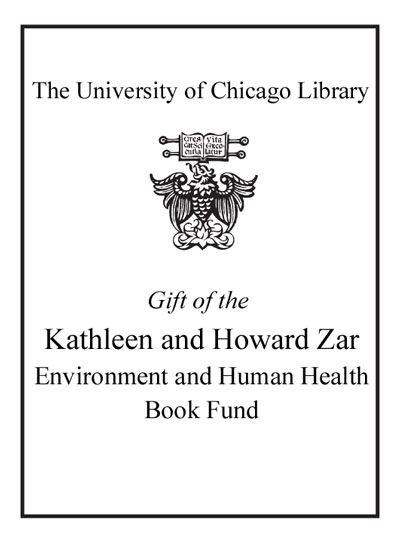Indoor air quality engineering : environmental health and control of indoor pollutants /
Saved in:
| Author / Creator: | Heinsohn, Robert Jennings. |
|---|---|
| Imprint: | New York ; Basel : Marcel Dekker, 2003. |
| Description: | xxxii, 870 p. : ill. ; 26 cm. |
| Language: | English |
| Subject: | |
| Format: | Print Book |
| URL for this record: | http://pi.lib.uchicago.edu/1001/cat/bib/6223303 |
Table of Contents:
- Preface
- Nomenclature
- Chapter 1. Introduction
- 1.1. Indoor Air Pollution and Risks
- 1.2. Management and Assessment of Risk
- 1.3. Liability
- 1.4. Indoor Air Pollution Control Strategy
- 1.5. Fundamental Calculations
- 1.6. Government Regulations
- 1.7. Standards
- 1.8. Contributions from Professionals
- 1.9. Components of Industrial Ventilation Systems
- 1.10. Classification of Ventilation Systems
- 1.11. Deficiencies in Present Knowledge
- 1.12. Professional Literature
- 1.13. Closure
- Chapter 1 Problems
- Chapter 2. The Respiratory System
- 2.1. Physiology
- 2.2. Respiratory Fluid Mechanics
- 2.3. Analytical Models of Heat and Mass Transfer
- 2.4. Toxicology
- 2.5. Sick Buildings
- 2.6. Bioaerosols
- 2.7. Dose-Response Characteristics
- 2.8. Risk Analysis
- 2.9. Closure
- Chapter 2 Problems
- Chapter 3. Design Criteria
- 3.1. Contaminant Exposure Levels
- 3.2. Instruments to Measure Pollutant Concentration
- 3.3. Fire and Explosion
- 3.4. Hearing and Noise
- 3.5. Thermal Comfort and Heat Stress
- 3.6. Odors
- 3.7. Radiation
- 3.8. General Safety
- 3.9. Engineering Economics
- 3.10. Closure
- Chapter 3 Problems
- Chapter 4. Estimation of Pollutant Emission Rates
- 4.1. Experimental Measurements
- 4.2. Empirical Equations
- 4.3. Emission Factors
- 4.4. Puff Diffusion
- 4.5. Evaporation and Diffusion
- 4.6. Drop Evaporation
- 4.7. Leaks
- 4.8. Closure
- Chapter 4 Problems
- Chapter 5. General Ventilation and the Well-Mixed Model
- 5.1. Definitions
- 5.2. Thermodynamics of Unventilated Enclosures
- 5.3. Dillution Ventilation with 100% Make-up Air
- 5.4. Time-Varying Source, Ventilation Flow Rate, or Make-up Air Concentration
- 5.5. Removal by Solid Surfaces
- 5.6. Recirculation
- 5.7. Partially Mixed Conditions
- 5.8. Well-Mixed Model as an Experimental Tool
- 5.9. Clean Rooms
- 5.10. Infiltration and Exfiltration
- 5.11. Split-Flow Ventilation Booths
- 5.12. Mean Age of Air and Ventilation Effectiveness
- 5.13. Make-up Air Operating Costs
- 5.14. Tunnel Ventilation
- 5.15. Closure
- Chapter 5 Problems
- Chapter 6. Present Local Ventilation Practice
- 6.1. Control of Particles
- 6.2. Control of Vapors from Open Surface Vessels
- 6.3. Control Systems for Specific Applications
- 6.4. Bulk Materials Handling
- 6.5. Canopy Hoods for Buoyant Sources
- 6.6. Air Curtains for Buoyant Sources
- 6.7. Surface Treatment
- 6.8. Building Air Inlets and Exhaust Stacks
- 6.9. Unsatisfactory Performance
- 6.10. Exhaust Duct System Design
- 6.11. Fan Performance and Selection
- 6.12. Closure
- Chapter 6 Problems
- Chapter 7. Ideal Flow
- 7.1. Fundamental Concepts
- 7.2. Two-Dimensional Flow Fields
- 7.3. Elementary Planar Ideal Flows
- 7.4. Elementary Axisymmetric Ideal Flows
- 7.5. Flanged and Unflanged Inlets in Quiescent Air
- 7.6. Flanged and Unflanged Inlets in Streaming Flow
- 7.7. Multiple Flanged Rectangular Inlets
- 7.8. Flanged Inlets of Arbitrary Shape
- 7.9. Closure
- Chapter 7 Problems
- Chapter 8. Motion of Particles
- 8.1. Particle Size
- 8.2. Statistical Analysis of Aerosols
- 8.3. Overall Collection Efficiency
- 8.4. Equations of Particle Motion
- 8.5. Freely Falling Particles in Quiescent Media
- 8.6. Horizontally Moving Particles in Quiescent Air
- 8.7. Gravimetric Settling in a Room
- 8.8. Gravimetric Settling in Ducts
- 8.9. Clouds
- 8.10. Stokes Number
- 8.11. Inertial Deposition in Curved Ducts
- 8.12. Closure
- Chapter 8 Problems
- Chapter 9. Removing Particles from a Gas Stream
- 9.1. Cyclone Collectors
- 9.2. Other Inertial Separation Collectors and Sampling Issues
- 9.3. Impaction between Moving Particles
- 9.4. Filtration
- 9.5. Electrostatic Precipitators
- 9.6. Engineering Design - Selecting and Sizing Particle Collectors
- 9.7. Hoppers
- 9.8. Closure
- Chapter 9 Problems
- Chapter 10. Application of CFD to Indoor Air Quality
- 10.1. Fundamentals of CFD
- 10.2. Flow around a Circular Cylinder
- 10.3. Modeling of Air Flows with Gaseous Contaminants
- 10.4. Modeling of Aerosol Particle Trajectories
- 10.5. Closure
- Chapter 10 Problems
- Appendices
- References
- Index


